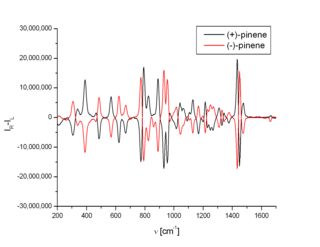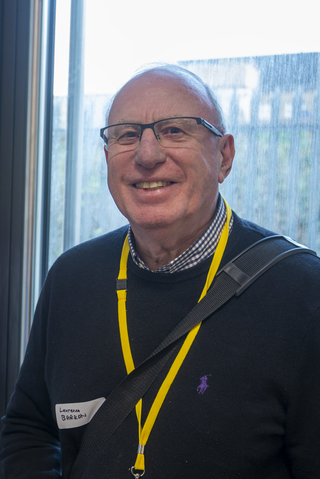
In optics, a dichroic material is either one which causes visible light to be split up into distinct beams of different wavelengths (colours), or one in which light rays having different polarizations are absorbed by different amounts.
Circular dichroism (CD) is dichroism involving circularly polarized light, i.e., the differential absorption of left- and right-handed light. Left-hand circular (LHC) and right-hand circular (RHC) polarized light represent two possible spin angular momentum states for a photon, and so circular dichroism is also referred to as dichroism for spin angular momentum. This phenomenon was discovered by Jean-Baptiste Biot, Augustin Fresnel, and Aimé Cotton in the first half of the 19th century. Circular dichroism and circular birefringence are manifestations of optical activity. It is exhibited in the absorption bands of optically active chiral molecules. CD spectroscopy has a wide range of applications in many different fields. Most notably, UV CD is used to investigate the secondary structure of proteins. UV/Vis CD is used to investigate charge-transfer transitions. Near-infrared CD is used to investigate geometric and electronic structure by probing metal d→d transitions. Vibrational circular dichroism, which uses light from the infrared energy region, is used for structural studies of small organic molecules, and most recently proteins and DNA.

Raman optical activity (ROA) is a vibrational spectroscopic technique that is reliant on the difference in intensity of Raman scattered right and left circularly polarised light due to molecular chirality.
Padmanabhan Balaram is an Indian biochemist and a former director of the Indian Institute of Science in Bangalore, India. He is a recipient of the third highest Indian civilian honour of Padma Bhushan (2014) as well as the TWAS Prize (1994). He has been conferred the 2021 R. Bruce Merrifield Award by the American Peptide Society.

Molecular biophysics is a rapidly evolving interdisciplinary area of research that combines concepts in physics, chemistry, engineering, mathematics and biology. It seeks to understand biomolecular systems and explain biological function in terms of molecular structure, structural organization, and dynamic behaviour at various levels of complexity. This discipline covers topics such as the measurement of molecular forces, molecular associations, allosteric interactions, Brownian motion, and cable theory. Additional areas of study can be found on Outline of Biophysics. The discipline has required development of specialized equipment and procedures capable of imaging and manipulating minute living structures, as well as novel experimental approaches.
Vibrational circular dichroism (VCD) is a spectroscopic technique which detects differences in attenuation of left and right circularly polarized light passing through a sample. It is the extension of circular dichroism spectroscopy into the infrared and near infrared ranges.
Linear dichroism (LD) or diattenuation is the difference between absorption of light polarized parallel and polarized perpendicular to an orientation axis. It is the property of a material whose transmittance depends on the orientation of linearly polarized light incident upon it. As a technique, it is primarily used to study the functionality and structure of molecules. LD measurements are based on the interaction between matter and light and thus are a form of electromagnetic spectroscopy.

Laurence David Barron has been Gardiner Professor of Chemistry at the University of Glasgow since 1998. He is a chemist who has conducted pioneering research into the properties of chiral molecules — defined by Lord Kelvin as those that cannot be superimposed onto their mirror image. By extending this definition of chirality to include moving particles and processes that vary with time, he has made a fundamental theoretical contribution to the field. Chiral molecules such as amino acids, sugars, proteins, and nucleic acids play a central role in the chemistry of life, and many drug molecules are chiral. Laurence's work on Raman optical activity — a spectroscopic technique capable of determining the three-dimensional structures of chiral molecules, which he predicted, observed, and applied to problems at the forefront of chemistry and structural biology — has led to its development as a powerful analytical tool used in academic and industrial laboratories worldwide. His much-cited book, Molecular Light Scattering and Optical Activity, has contributed to the growing impact of chirality on many areas of modern science.
Bengt Johan Fredrik Nordén is a Swedish chemist.
The following outline is provided as an overview of and topical guide to biophysics:

Thomas Welton is a professor of sustainable chemistry at Imperial College London. He served as head of the department of chemistry from 2007 to 2014 and as dean of the faculty of natural sciences from 2015 to 2019. He is a Fellow and the former president of the Royal Society of Chemistry. Welton's research focuses on sustainable chemistry, with particular focus on ionic liquids and on solvent effects on chemical reactions. Welton is openly gay and is active in advocating for greater visibility for members of the LGBT community in the sciences. He is a member of the UKRI Equality, Diversity and Inclusion External Advisory Group.
Athena SWAN is an equality charter mark framework and accreditation scheme established and managed by the UK Equality Challenge Unit in 2005 that recognises and celebrates good practices in higher education and research institutions towards the advancement of gender equality: representation, progression and success.
Cinzia Casiraghi is a Professor of Nanoscience in the Department of Chemistry at the University of Manchester and National Graphene Institute in the UK.

Helen Jane Dyson is a British-born biophysicist and a professor of integrative structural and computational biology at the Scripps Research Institute in La Jolla, California. She was the 15th editor-in-chief of the Biophysical Journal. She was elected a Member of the National Academy of Sciences in 2022.
Karen Jane Faulds is a Scottish academic and Professor of Analytical Chemistry at the University of Strathclyde. She develops surface-enhanced Raman spectroscopy (SERS) for bioanalysis, and has won several awards for her research, including the Coblentz Society Craver Award.

Nina D. Berova is a Professor of Chemistry at Columbia University. She is recognised as a world leader in stereochemistry and chiroptical spectroscopy. Her contributions include the development of porphyrin tweezers. She was the 2007 winner of the Società Chimica Italiana Chirality Medal.

Hyper–Rayleigh scattering optical activity, a form of chiroptical harmonic scattering, is a nonlinear optical physical effect whereby chiral scatterers convert light to higher frequencies via harmonic generation processes, in a way that the intensity of generated light depends on the chirality of the scatterers. "Hyper–Rayleigh scattering" is a nonlinear optical counterpart to Rayleigh scattering. "Optical activity" refers to any changes in light properties that are due to chirality.
Susan Davis Allen is an American engineering professor and academic administrator. She is currently Associate Dean of Research for the College of Engineering and Distinguished Professor of Mechanical Engineering at Embry-Riddle Aeronautical University. Her research has spanned multiple applications of lasers and optics, including spectroscopy, laser sensors, laser ablation, micromachining, and others.

Bonnie Ann Wallace, FRSC is a British and American biophysicist and biochemist. She is a professor of molecular biophysics in the department of biological sciences, formerly the department of crystallography, at Birkbeck College, University of London, U.K.
Synchrotron radiation circular dichroism spectroscopy, commonly referred to as SRCD and also known as VUV-circular dichroism or VUVCD spectroscopy, is a powerful extension to the technique of circular dichroism (CD) spectroscopy, often used to study structural properties of biological molecules such as proteins and nucleic acids. The physical principles of SRCD are essentially identical to those of CD, in that the technique measures the difference in absorption (ΔA) of left (AL) and right (AR) circularly polarized light (ΔA=AL-AR) by a sample in solution. To obtain a CD(SRCD) spectrum the sample must be innately optically active (chiral), or, in some way be induced to have chiral properties, as only then will there be an observable difference in absorption of the left and right circularly polarized light. The major advantages of SRCD over CD arise from the ability to measure data over an extended wavelength range into the vacuum ultra violet (VUV) end of the spectrum. As these measurements are utilizing a light source with a higher photon flux than a bench-top CD machine it means data are more accurate at these extended wavelengths because there is a larger signal over the background noise and, generally, less sample is needed when recording the spectra and there is more information content available in the data. Many beamlines now exist around the world to enable the measurement of SRCD data.









